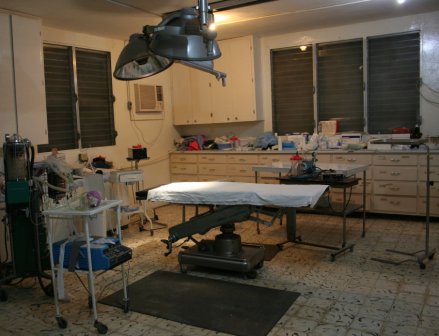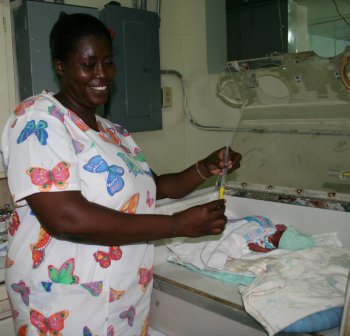Editor’s Note: This article was scheduled to run today weeks ago–long before the earthquake. Haiti needs the prayers and actions of Christians everywhere. It’s hard for many of us to comprehend the devastation they are experiencing, much less realize the depth of poverty that was part of their lives before the earthquake. Sarah’s article gives us a glimpse into the needs of Haiti through the eyes of a Christian nurse. If you can give, find out if your denomination is sending in teams. If not, consider Sarah’s church (link below) or well-established and trained groups such the American Red Cross, Salvation Army, and Samaritan’s Purse (Franklin Graham) emergency response teams. Kellie Renfroe
When I awoke to the sound of roosters crowing, I quickly remembered that I wasn’t home. I had the enthralling opportunity to spend eight days living inside another culture this past February when I went with a group from Chichester United Wesleyan Church on a short term mission trip to Haiti. This country is considered by some to be the poorest area in the western hemisphere. My reason for going was because Jesus’s love changed me and I want to share that with others. Looking back, I must say that I gained much more than I gave on this venture.
My first stop was the Walls International Guest House in Port au Prince, which advertises 24-hour armed guards. The walls are topped with barbed wire, and I noticed that the guards continually have their guns in hand. The landscaping is beautiful, and it is quite a contrast inside the walls compared to the dusty, barren streets outside. As all the guests enjoyed a buffet meal together, those who had been there before didn’t miss a beat when the lights flickered or went out briefly. They explained that in Port au Prince sometimes you have electricity and sometimes you don’t.
The next morning the adventure continued as I took a two-hour drive to the dock. We travelled over roads ranging from stretches filled with huge ruts and potholes to newly paved areas. The drive was like nothing I’ve ever experienced, with no real discernable traffic patterns and random sights like baby goats crossing the road and people in a wide range of attire walking down the streets. The dusty road did not prevent one pedestrian from wearing his beautiful white suit.
The Wesleyana, a sailboat with two power motors was the next mode of transportation. It carried me 12 miles from the Haitian mainland to the island of La Gonave, where the Wesleyan mission station is located. This trip took about 1 hour and 40 minutes in the brilliant, hot sun. I was very thankful that I had a water bottle with me. The Caribbean Sea was a gorgeous blue, but again there was a strange contrast as I noticed an abundance of plastic trash floating in the water.
Beth Gould is an operating room nurse from Canada who is currently serving as a full-time missionary. She gave me a tour of the La Gonave Wesleyan Hospital, a 32 bed facility which is the only hospital serving the approximately 120,000 residents on the island. The staff of the hospital has an amazing knowledge base that enables them to care for a wide variety of patients. There are no specialized areas; all the nurses care for all the patients.
What is lacking in resources is definitely made up for in resourcefulness. For example, the nurses were caring for a premature infant. They kept this baby in an incubator in the nurses’ station to watch him more closely. The incubator was not heated, so they placed a hot water bottle in with the baby and a thermometer to monitor the temperature. They had also inserted a small feeding tube to provide nutrition.
Their “intensive care unit” is simply the hall directly outside the nurses’ station. They place any critical patients on a stretcher within view in order to monitor unstable patients. When I visited, this space was occupied by a woman who had been brought in during the night unresponsive and with a high fever. She was treated with IV fluids and antibiotics. She responded well to the quick and appropriate treatment and regained consciousness by the next day.
One fascinating aspect of hospital care in La Gonave is that families always accompany the patient. As a matter of fact, it is common to see at least 2 people in each bed (and several beds per room) because family members stay with their loved ones 24 hours/day. The families are responsible for providing meals for the patient, as well as doing their laundry and taking care of their basic needs such as bathing. Meals are cooked right in the hospital courtyard. There are a few vendors who also sell food and drinks.
After the birth of a baby, it is common practice for the family to take care of disposing of the placenta. The hospital staff places the placenta in a basin for the family. I was reminded of cultural differences in other ways as well. There are no washers or dryers, so all the laundry is done by hand. The autoclave is the type from an old MASH unit, and there is only one electrocautery machine and one suction machine. Chickens, roosters, and dogs roam freely through the hospital courtyard. In the marketplace there are medicines for sale right alongside shoes and other assorted items.
After a day in the operating room I was again impressed by the skill of the nurses. Complex surgeries are carried out with excellent sterile technique and precision, in spite of the limited equipment. Medicinal supplies are meager as well, so that most surgeries are done with spinal and local anesthesia. It was strange to realize that a young man was awake during his hernia repair. He was shielded from seeing the operation and was attentively monitored throughout his surgery.
The expertise of this hospital staff is remarkable. From premature babies to motorcycle accident victims to septic patients to surgical patients, all are cared for with proficiency. They share the love of Jesus by meeting the practical needs of the Haitian people.
Most of the methods used are helping Haitians to stand on their own. For example, Beth Gould was in the midst of training Haitian nurses to work in the operating room so they will have a team of surgical nurses.
I had the opportunity to see some of the other projects helping the Haitian people of La Gonave as well. There is an orphanage that provides a home and education for approximately 40 children. It was great fun playing with the children and seeing their amazement when they were shown their own pictures in the digital camera display.
I thoroughly enjoyed this adventure and the many experiences it afforded, but also came home with a deeper appreciation of all the readily available supplies and resources in my own hospital. I do miss the beautiful Haitian sunrises and the warm greetings of Bon Jour, though!
Sarah Riddle
To find out more visit www.chiunited.org/Missions/Haiti





